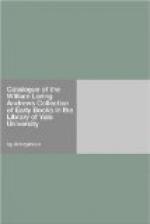Apart from the interest attaching to this “Liber ultimus” as the only original work of any length from Caxton’s pen, the Polychronicon is next to the Golden Legend his largest book, and in the Prohemye they are grouped together as the “twoo bookes notable” which treat of history. It happens also, probably because of larger editions printed, that of these two books many more copies have survived than of any of his other books, about one-fourth of which are now represented only by single copies. Of the Polychronicon, Seymour de Ricci’s “Census of Caxtons” (1909) enumerates forty known copies (very few of them entirely complete), evenly divided between public and private libraries. To this list he adds, under the heading “Present owners untraced,” forty-eight copies (nos. 41-88) which appeared at sales between 1698 and 1901, some of them possibly identical with copies already described as “known.” In this second division is found the present copy (no. 79), purchased by the donor of this collection at the Smets sale, New York, May, 1868, in calf binding, with the name of the owner “A.A. Smets, Savannah, May 28, 1836” on the fly-leaf. It was at once sent to Francis Bedford for binding, with instructions to have the “inlaying, repairing etc. done over in the very best manner, by the best restorer in France or England.” Bound in brown morocco, richly blind-tooled, with Tudor rose, fleur-de-lis and acorn emblems. Leaf 10-1/4 x 7-1/2 in. The Smets fly-leaf and the original instructions sent to Mr. Bedford with the volume and returned by him with an added note over his own signature, laid in.
Other copies of the Polychronicon which have passed through Mr. Bedford’s hands have been bound in the same style, among them the Menzies copy, sold New York, November, 1876, which de Ricci wrongly conjectured might be identical with the Smets.
25. ORDINARY OF CHRISTIAN MEN. London, Wynkyn de Worde, 1506.
Fol. 1^a. TITLE: Thordinary of Crysten men [woodcut below.] Fol. 1^b-4^b, table of contents. Fol. 5^a [woodcut above]: Here begynneth a notable treatyse and ful necessarye to all crysten men for to knowe & it is named the Ordynary of Crystyens or of crysten men. Fol. 217^b: Here endeth the book named the ordynarye of crysten men newely hystoryed and translated out of Frensshe in to Englysshe. Enprynted in the cyte of London in the Fletestrete in the sygne of y^e sonne by Wnykyn de worde. y^e yere of our lorde .M.CCCCC.vi. Fol. 218^a, title repeated over woodcut. Fol. 218^b, [PRINTER’S DEVICE]




